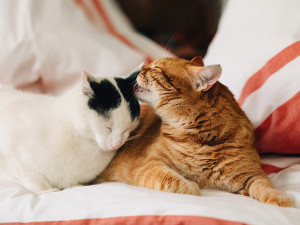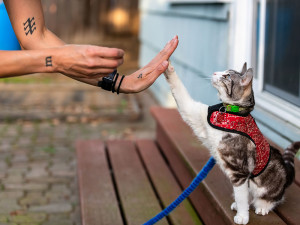8 Myths About Your Kitten—Busted By a Behaviorist
Forget everything you think you know about baby cats.

share article
Raising well-behaved, happy, and healthy kittens is so much easier if you are unencumbered by a belief in any of the common myths about them. We can enjoy the mythology of cats like Bastet of Ancient Egypt and ‘Gdon of Tibetan lore while keeping mythology out of the lives of our real cats. Debunking the myths about kittens makes it easier for them to adjust to their new home and for everyone to live and love happily ever after.
Myth: It’s a good idea to get kittens as young as possible so they bond with you better.
No, it’s not a good idea. It’s actually a bad idea, and here’s why. Kittens who are taken away from their mother and their littermates before they are eight weeks old miss out on many lessons they can only learn from their mom and their brothers and sisters, and being with them until the age of 10 to 12 weeks may be even more beneficial.
They need to learn how to play, how to interact socially, how to groom themselves, and so much more before being separated. Kittens who leave their mom and littermates too early are more likely to be fearful, to have trouble handling stress, to play too rough, and to be quick to bite and scratch people, especially strangers.
If removed too early from their first family, kittens are more likely to pee and poop outside the litterbox, meow and yowl excessively, suck on blankets or other objects, and to be aggressive. And when you welcome kittens who are two to three months old, they are still so young and can bond to you deeply and thoroughly.
Myth: Kittens are nocturnal so they’re destined to be active all night and sleep much of the day.
Nope, and thankfully so, because that would put our schedules at complete odds with one another. Kittens, like cats of other ages, are not actually nocturnal. They are crepuscular, which means they are most active at dawn and at dusk. They sleep more hours than people do, but not in one long stretch.
Kittens sleep 18 to 20 hours a day but if you’ve heard of the cat nap, you know much of that sleep is in short sessions. Kittens fall asleep and wake up many times throughout a 24-hour day, including during the night, but their natural tendency to have many periods of activity at night can certainly be modified, especially as they get older.
To help kittens sleep well at night, have lots of play and activity sessions during the day so they snooze a little less, and have a big play session before bed to tire them out before settling in for the night. It also helps to feed them late at night; all that digesting work can help them rest well.
Make sure that late meal is part of their daily food intake and not in addition to what they should be eating. Don’t reinforce playfulness and attention-seeking behavior opens in a new tab at night or they will learn that you are available then. If they attempt to disturb you, make sure it doesn’t work for them by resulting in your attention or the habit will become stronger.
Myth: Kittens can’t be trained.
Yes, they absolutely can be trainedopens in a new tab, and they should be trained. Although this myth is known to be false by more and more people, it has a persistence that doesn’t serve anybody. Somehow kittens have a weird PR problem when it comes to training that seems to be based on nothing more than not being puppies.
Cats of all ages, including kittens, can be trained. Common skills to teach kittens include sitting on cue, entering their crate, using the litterbox, going to a particular spot on the floor, how to play nicely (using toys instead of your hands!), responding to their name, playing fetch, and coming when called.
Myth: Kittens can’t get along with dogs.
Yes, they can, but they need to be introduced properlyopens in a new tab to avoid negative interactions that can lead to relationship challenges between them. Proper introductions offer the best opportunity for kittens and dogs to be the best of friends. It’s important to introduce them the right way because any bad interaction makes it that much harder to move forward in their relationship.
Introducing dogs to kittensopens in a new tab all too often leads to trouble because a common but ill-advised strategy is to put them in a room together and hope for the best. Even sweet dogs who are fond of kittens may chase them and accidentally teach kittens that dogs are to be feared and are certainly not to be trusted.
Physical damage to kittens is also a risk. If an initial dog and cat introductionopens in a new tab doesn’t go well, it will be hard to turn that relationship around, so the most important piece of advice about introducing cats to dogs is do it right because you can’t do it over. Be patient and think in terms of months or weeks rather than days.
Accustom the dog and the kitten to the sight and smell of one another with a gate between them. Encourage positive feelings by giving them lots of toys, treats, and attention while they are near each other but can’t interact.
Once they are calm and comfortable in the presence of one another, it’s time to work without a gate, but with leashesopens in a new tab, keeping their experiences positive with treats, petting, and toys. If this step goes well after a series of repetitions over a period of weeks, only then can they be in the same space unrestrained, and even then they must be supervised so if anyone gets upset or acts in a way that could upset the other, they can be immediately separated.
A caveat: Not every dog is safe around kittens. Kittens can only get along with dogs who have been socialized to kittens and are able to act appropriately around them.
Myth: Kittens are low-maintenance.
For far too long, many people who wanted an animal companion but didn’t want to put a lot of time or effort into caring for that animal opted to adopt a kitten. Based on the myth that they are low-maintenance, many kittens arrived in new homes and their needs were not adequately met. Sure, many kittens seemed to do OK, but their quality of life was not what it could have been. Kittens’ lives are better when we acknowledge they have needs and we work hard to satisfy them. Doing so is not a low-maintenance situation.
Kittens require grooming (some daily), their litter boxes must be cleaned often (ideally daily), and they require regular visits to the veterinarian for health care. They need a lot of attention to keep them satisfied rather than bored, and they require lots of activity for both their bodies and their brains.
Between training sessions, play sessions, and other forms of enrichment such as kitty condos, cozy beds where the sun hits them, affection, and lots of toys, these needs can be met. Taking care of a kitten and providing all they need to have the best life possible is not a match for the term “low-maintenance.”
Myth: Kittens are anti-social.
It’s just not so. Kittens are generally very social, and these social tendencies lead them to seek the company of other catsopens in a new tab and of people. They benefit from having both cat and human play partners (and sometimes dog buddies, too). They also thrive on receiving attention in the form of grooming, petting, and snuggling.
The tide is turning on the myth of anti-social kittens enough that it’s become common knowledge that it’s better to adopt a pair of kittensopens in a new tab rather than a single one. The persistence of the erroneous idea that kittens are anti-social may be because many kittens (and grown-up cats, too!) tend to enjoy some time by themselves as well. So, expect most kittens to want to spend time with others and also to be clear when they are done with the interaction and desire some space for a bit.
Myth: Unlike puppies, kittens don’t need to be socialized.
Au contraire! Socializing kittensopens in a new tab is critically important to their development and strongly impacts their behavior throughout their lives, as well as their future happiness. Kittens who are well-socialized are more likely to develop into adult cats who do well with other cats, dogs, children, adults, and being handled.
The main differences between puppy socialization and kitten socialization is that kittens have a shorter socialization period and it starts earlier in life compared with puppies. During the time that kittens are two to seven weeks old, their brains are very open to new experiences, situations, objects, and social partners. During this developmental stage, even a few positive experiences with anything new can teach a cat to be fine with those new things for their whole life.
For socialization to be effective and allow a kitten the best chance at being able to handle what they will encounter for all the years to come, provide many positive experiences for kittens with a variety of people, places, and things. They should have pleasant exposures being introduced to people, dogs, and other cats as well as the sounds and objects so common inside and outside the house, different types of walking surfaces, and a variety of smells.
Proper socialization of kittens includes handling them gently, spending time with them in each room of the house, and letting them see and hear kitchen appliances, as well as the vacuum and fans. Introduce them to the car, their car carrier, the vet and the staff at the clinic, and start using a hairbrush, a collar, maybe a harness and leash, and nail clippers. Take great care to avoid scaring kittens or overwhelming them. Using great treats and being very gentle are important for making all these experiences positive.
Myth: Kittens make their own fun so you don’t have to entertain them.
Not true. Kittens need and deserve our attention and interaction. They need opportunities to playopens in a new tab and to interact with us in a variety of ways, and they benefit from enrichment in so many forms. It’s up to us to provide them with various types of entertainment. Kitten enrichment can take many forms.
It can be play with a variety of interactive toys and regular training sessions to teach them skills and allow them the satisfaction of getting reinforced for being right. Enrichment can also be the opportunity to access vertical spacesopens in a new tab and other fun places, such as kitty condosopens in a new tab. Although kittens can play independently some of the time (especially if we offer them toys that help them do this), they also need the fun and entertainment of interactions with us.

Karen B. London, PhD, CAAB, CPDT-KA
Karen B. London, Ph.D., is a Certified Applied Animal Behaviorist and Certified Professional Dog Trainer who specializes in working with dogs with serious behavioral issues, including aggression, and has also trained other animals including cats, birds, snakes, and insects. She writes the animal column for the Arizona Daily Sun and is an Adjunct Professor in the Department of Biological Sciences at Northern Arizona University. She is the author of six books about training and behavior, including her most recent, Treat Everyone Like a Dog: How a Dog Trainer’s World View Can Improve Your Lifeopens in a new tab.
Related articles
![A hand reaching towards a cat peaking out of a cage.]() opens in a new tab
opens in a new tab10 Questions to Ask a Shelter About an Adoptable Cat
From medical history to adoption fees to litter preferences, here is everything you need to know.
![two bonded kittens snuggling]() opens in a new tab
opens in a new tabWhy You Should Adopt a “Less Adoptable” Cat
Here’s why bonded kitties, senior cats, and felines with FIV make just as amazing pets as any other.
![cat playing fetch]() opens in a new tab
opens in a new tabHow to Train a Cat
Move over, pups. This is a cat’s game, too.
![Training a cat sitting with leash and harness on.]() opens in a new tab
opens in a new tabA Step by Step Guide on How to Clicker Train Your Cat
This popular training technique isn’t just for dogs. Here’s how you can use it for your cat.
- opens in a new tab
Dream of High-Fiving Your Cat? Here’s How to Teach a Cat Tricks
It takes some patience (shocker), but it can be done.







